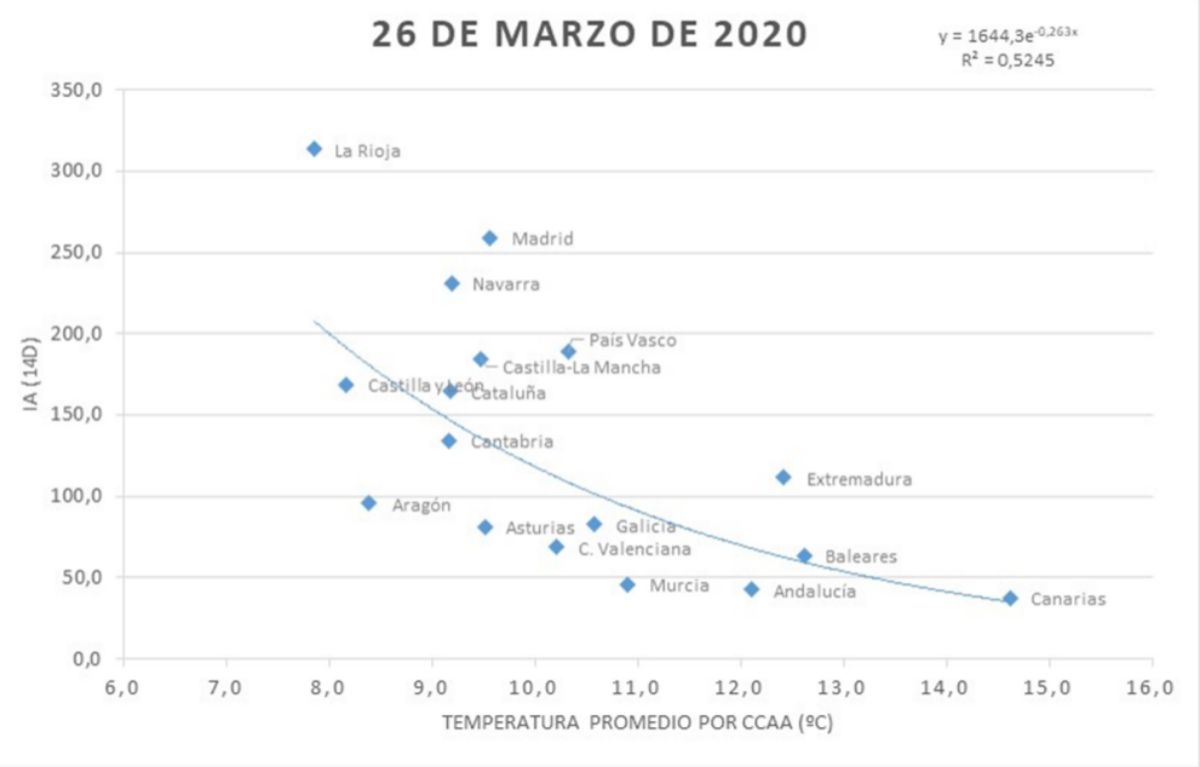- Covid-19. Last minute on the coronavirus
- Office. Locked up at home, where do I get vitamin D?
- Pollution: The Himalayas can be seen from Indian cities for the first time in decades
- Because of the coronavirus: this is how pollution has fallen in the cities of Spain
One of the unknowns about the current coronavirus pandemic is whether, as with other viruses, heat will weaken SARS-CoV-2. Scientists have so far been very cautious, but a Spanish study published on Tuesday indicates that, as previously suspected, high temperatures seem to slow its spread by reducing its incidence.
The research, developed jointly by the State Meteorological Agency (AEMET) and the Carlos III Health Institute (ISCIII), is based on the analysis of the period from March 26 to April 5. Scientists have observed that the lower the temperature, the higher the incidence of Covid-19 and with it, the greater the spread.
But his observations show that not only do temperatures influence : humidity could also affect the contagion curve . High temperatures and high humidity reduce the transmission and spread of the virus, so springtime in the northern hemisphere could help fight Covid-19, according to this study.
"Our results are in line with what we have seen in the bibliography and that is that the accumulated affectation, which is the index, increases when temperatures are lower," explains Fernando Belda, meteorologist at AEMET in a telephone conversation. The scientist emphasizes that this conclusion is based on meteorological data and that, "naturally, there are other components, social and economic, in each Autonomous Community that are decisive in the evolution of the pandemic."
As Belda explains, to carry out this work, the accumulated incidence rate in the last 14 days (that is, the number of new daily infections per 100,000 inhabitants) was compared with the average temperature that occurred in each Autonomous Community of Spain. . Their analysis revealed that the lower the average temperature, the greater the incidence.
"If we go community by community, the behavior is slightly different, although it is maintained that the lower the temperature, the greater the impact," he points out. "For example, Asturias has moved these days between 8 and 10 degrees while the Canary Islands has been between 14 and 17, which is a significant difference," he adds.
Although taken with caution, these preliminary data are encouraging for Spain, which, also according to AEMET data, has experienced the warmest winter since this century began . The quarter from December 2019 to February 2020 recorded the second highest average temperature since data collection, surpassed only by the winter of 1989-90. The maximum temperatures recorded last winter were also the highest since 1965. On the other hand, while February was extremely dry, March was very rainy , doubling the values of normal precipitation for this month.
The role of pollution
These results may lead us to think that infections will decrease in our country as temperatures continue to rise with the arrival of summer. However, Belda clarifies that, "although high temperatures are a favorable component to reduce propagation, in summer there are situations of great stability that generate a lot of contamination , for example in Madrid. Summarizing: on the one hand, heat can cause it to spread less, but can also lead to situations more prone to the spread of the virus. "
And is that in addition to studying the link between meteorology and the spread of Covid-19, researchers from AEMET and ISCIII are analyzing the impact of other environmental factors such as air pollution, on the development of the pandemic. Comparing pollution levels with data on hospital admissions, ICU admissions and mortality rate, can improve the identification of risk areas and establish diagnostic and prevention strategies.
According to Belda, they began to collect data for this study on March 12 and now they are going to incorporate more variables, such as absolute humidity (which is what truly says the amount of water vapor in the atmosphere), ultraviolet radiation , the pollution of cities and the intrusion of Saharan dust to understand what implications they have in the spread of the coronvirus: "We know, for example, that Saharan dust influences other respiratory diseases, " he points out.
"Our final objective is to identify risk areas in real time and to be able to develop an early warning system," says the scientist at AEMET, a center that has collaborated for years with the Carlos III Health Institute.
In recent days, several international studies have shown the link between air pollution and a higher rate of deaths from coronavirus. A study carried out in the USA by scientists from Harvard University concludes that the inhabitants of the most polluted areas are more likely to die from coronavirus. The strip of United States territory located between New York and Boston presented more cases and higher mortality. Other cities such as Chicago, Detroit, Houston, Miami, Atlanta or Los Angeles are registering higher incidence.
As for Italy, research from the University of Siena suggests that high pollution could be behind high mortality in the most industrialized regions of the country (12% in Lombardy and Emilia Romagna compared to less than 5% in other zones.
According to the criteria of The Trust Project
Know more- Science and health
- science
- Coronavirus
- Covid 19
Covid-19 What happens when a coronavirus mutates? Lessons learned from SARS and other epidemics
Pandemic Covid-19Nadia, a tigress from the New York Zoo, tests positive for coronavirus
Covid-19Farewell to the daughter of a businessman killed by coronavirus: 'He begged us not to go see him'

